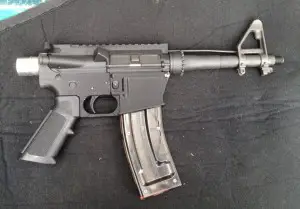 Unless you’ve been under a rock (like we were last week… and will be next… sigh) you’ve heard about the guy who made an AR-15 lower receiver on a 3D printer. We’ve been making noises for a while about the coming of desktop gun manufacturing, and now it’s come to pass. The picture shows the first documented desktop-printed AR to fire successfully: a .22 AR pistol using a CMMG barrel and parts, and conventional lower parts kit, apparently set in the holes made by the 3D printing process, then reamed to size. Several other operations were conducted on the lower, but by and large it’s as-printed, with brittle sacrificial support structures removed and some hand fitting.
Unless you’ve been under a rock (like we were last week… and will be next… sigh) you’ve heard about the guy who made an AR-15 lower receiver on a 3D printer. We’ve been making noises for a while about the coming of desktop gun manufacturing, and now it’s come to pass. The picture shows the first documented desktop-printed AR to fire successfully: a .22 AR pistol using a CMMG barrel and parts, and conventional lower parts kit, apparently set in the holes made by the 3D printing process, then reamed to size. Several other operations were conducted on the lower, but by and large it’s as-printed, with brittle sacrificial support structures removed and some hand fitting.
No, he didn’t desktop print the whole gun, but it is a receiver, and it has been tested, at first with a .22 pistol upper, and then with a 5.56. It’s a living example of the crawl, walk, run principle. But it’s the first.
The media reporting has been (as usual) dreadful. See the hyperbole here and here — neither of which had the class to link to the actual inventor/manufacturer. But that’s the profession of journalism for you.
Let’s let the author of this revolution himself say a few words about the techical details:
If you have access to a CAD package, I highly recommend working from the original IGES file and not an STL if you want to print a lower receiver. Firearms require a good deal more precision than a Bre Pettis bobblehead, and working from a proper CAD model will allow you to tweak hole diameters and add reinforcement in critical areas. In this case, I opted to add extra support to the front takedown pin lugs, added an integral trigger guard, and reinforced the area around the bolt hold. However, I’m still skeptical of how well the bolt hold crosspin holes will fare and will test without that feature to start with.
Justin’s original IGES file actually has the buffer tube threads as modeled features, so I output the STL at a very high resolution (hence the 46 meg file). Much to my delight, when I printed the receiver on my Stratasys, a buffer tube could be screwed right into the rear of the receiver with no touchup of the threads needed (a good thing, as the special 1-3/16″-16 tap for the threads is rather expensive).
The WeaponsMan Mad Science Laboratory contains one and only one of those taps, and yeah, it was expensive. Not as expensive as a professional-level prototyping 3D FDM printer — even an old one like the 1990s-vintage Stratasys 1600 that was used here.
The developer had an interesting approach, and modeled his model, first, at 75%:
As this is a rather complex part, I recommend printing it out at 75% scale first (you can see my original 75% stock lower next to the final full size reinforced lower in one of the pictures). You’ll save a lot of time and material this way and get a good idea of how well features will be preserved on a full size print. I used PP3DP UP! filament for the 75% model and switched to black Bolson ABS for the full print. I’d love to try a polycarbonate/ABS blend for this part, but I have no idea if my printer will handle such material.
via Reinforced AR-15 Lower Receiver by HaveBlue – Thingiverse.
You can download the STL file at that link, or get the original IGES online at Justin Halford’s CNCGunsmithing (highly recommended).
Before you rush out to try to build an AR with a MakerBot, you might want to consider some more details. First, the guy is an experienced builder of things who’s at home in a machine shop, or more to the point, doing some troubleshooting, Are you? And it took a great deal of time: “a few days (no speed demons, these old machines)” the builder notes.
Finally, is this really the first? Michael is not so sure. He says:
To the best of my knowledge, this is the first 3D printed firearm (as per the definition in the GCA) in the world to actually be tested. However, I have a very hard time believing that it actually is. My Stratasys is a good 15 years old, and Duke Snider’s original AR-15 CAD files have been floating around on the ‘net since early 2000. As such, I can’t imagine that I’m the first person stupid adventurous enough to actually pull the trigger on a 3D printed receiver. If someone has beaten me to it, please leave a comment!
With that, we’ll leave you to ponder the implications, knowing a lot more from reading this than you’d get frm the TV, or Popular Science or National Review. But you’ll get the most detail by going to the author’s page (haveblue.org) and especially reading his two posts on printing and building an AR-15 lower: Part 1 and Part 2.

Kevin was a former Special Forces weapons man (MOS 18B, before the 18 series, 11B with Skill Qualification Indicator of S). His focus was on weapons: their history, effects and employment. He started WeaponsMan.com in 2011 and operated it until he passed away in 2017. His work is being preserved here at the request of his family.
